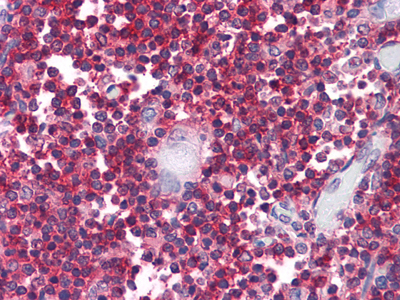CD247 Monoclonal Antibody(4B10)
- Catalog No.:YM0114
- Applications:WB;IHC;IF;FCM;ELISA
- Reactivity:Human
- Target:
- CD247
- Fields:
- >>Natural killer cell mediated cytotoxicity;>>Th1 and Th2 cell differentiation;>>Th17 cell differentiation;>>T cell receptor signaling pathway;>>Chagas disease;>>Epstein-Barr virus infection;>>Human immunodeficiency virus 1 infection;>>PD-L1 expression and PD-1 checkpoint pathway in cancer
- Gene Name:
- CD247
- Protein Name:
- T-cell surface glycoprotein CD3 zeta chain
- Human Gene Id:
- 919
- Human Swiss Prot No:
- P20963
- Mouse Swiss Prot No:
- P24161
- Immunogen:
- Purified recombinant fragment of human CD247 expressed in E. Coli.
- Specificity:
- CD247 Monoclonal Antibody detects endogenous levels of CD247 protein.
- Formulation:
- Liquid in PBS containing 50% glycerol, 0.5% BSA and 0.02% sodium azide.
- Source:
- Monoclonal, Mouse
- Dilution:
- WB 1:500 - 1:2000. IHC 1:200 - 1:1000. IF 1:200 - 1:1000. Flow cytometry: 1:200 - 1:400. ELISA: 1:10000. Not yet tested in other applications.
- Purification:
- Affinity purification
- Storage Stability:
- -15°C to -25°C/1 year(Do not lower than -25°C)
- Other Name:
- CD247;CD3Z;T3Z;TCRZ;T-cell surface glycoprotein CD3 zeta chain;T-cell receptor T3 zeta chain;CD antigen CD247
- Molecular Weight(Da):
- 19kD
- References:
- 1. J Immunol. 2002 Aug 15;169(4):1705-12.
2. Arthritis Rheum. 2003 Jul;48(7):1948-55.
3. Nat Methods. 2005 Aug;2(8):591-8.
- Background:
- The protein encoded by this gene is T-cell receptor zeta, which together with T-cell receptor alpha/beta and gamma/delta heterodimers, and with CD3-gamma, -delta and -epsilon, forms the T-cell receptor-CD3 complex. The zeta chain plays an important role in coupling antigen recognition to several intracellular signal-transduction pathways. Low expression of the antigen results in impaired immune response. Two alternatively spliced transcript variants encoding distinct isoforms have been found for this gene. [provided by RefSeq, Jul 2008],
- Function:
- disease:Defects in CD247 are a cause of primary T-cell immunodeficiency [MIM:610163]. Affected individuals suffer of recurrent infections. Patients T-cell counts are very low and B-cell counts are normal.,domain:The ITAM domains mediate interaction with SHB.,function:Probable role in assembly and expression of the TCR complex as well as signal transduction upon antigen triggering.,online information:CD247 mutation db,PTM:Phosphorylated on Tyr residues after T-cell receptor triggering.,similarity:Belongs to the CD3Z/FCER1G family.,similarity:Contains 3 ITAM domains.,subunit:The TCR/CD3 complex of T-lymphocytes consists of either a TCR alpha/beta or TCR gamma/delta heterodimer coexpressed at the cell surface with the invariant subunits of CD3 labeled gamma, delta, epsilon, zeta, and eta. CD3-zeta forms either homodimers or heterodimers with CD3-eta. Interacts with SLA and SLA2. Interacts w
- Subcellular Location:
- Cell membrane ; Single-pass type I membrane protein.
- Expression:
- CD3Z is expressed in normal lymphoid tissue and in peripheral blood mononuclear cells (PBMCs) (PubMed:11722641).
- June 19-2018
- WESTERN IMMUNOBLOTTING PROTOCOL
- June 19-2018
- IMMUNOHISTOCHEMISTRY-PARAFFIN PROTOCOL
- June 19-2018
- IMMUNOFLUORESCENCE PROTOCOL
- September 08-2020
- FLOW-CYTOMEYRT-PROTOCOL
- May 20-2022
- Cell-Based ELISA│解您多样本WB检测之困扰
- July 13-2018
- CELL-BASED-ELISA-PROTOCOL-FOR-ACETYL-PROTEIN
- July 13-2018
- CELL-BASED-ELISA-PROTOCOL-FOR-PHOSPHO-PROTEIN
- July 13-2018
- Antibody-FAQs
- Products Images

- Western Blot analysis using CD247 Monoclonal Antibody against CD247-hIgGFc transfected HEK293 cell lysate.

- Immunohistochemistry analysis of paraffin-embedded human Thymus tissues with AEC staining using CD247 Monoclonal Antibody.

- Immunofluorescence analysis of K562 cells using CD247 Monoclonal Antibody (green). Blue: DRAQ5 fluorescent DNA dye.

- Flow cytometric analysis of Jurkat cells using CD247 Monoclonal Antibody (green) and negative control (purple).



